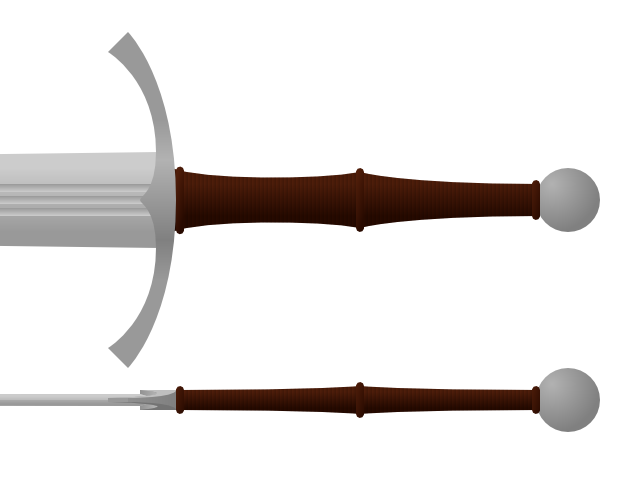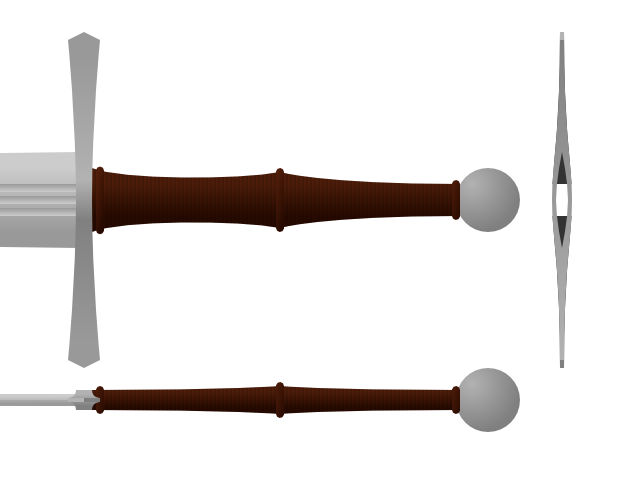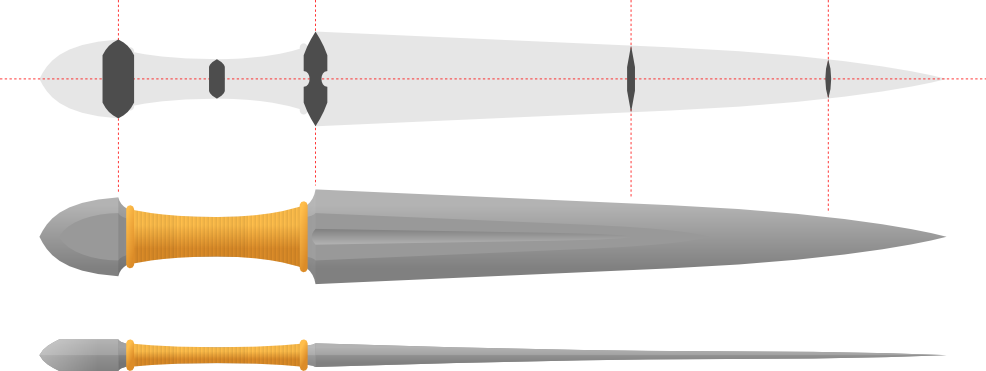|
|
Post by MOK on Apr 27, 2011 4:02:59 GMT
And a random ball-pommeled sword that, believe it or not, came to me in a dream last night.   It's 45 inches long overall. The blade is 34 inches, lenticular in cross-section with three short and narrow fullers; I'm not sure what Oakeshott type it would fall in, but it's similar to some German swords I've seen from around the beginning of the 16th Century. The grip is 9 inches long, wrapped with reddish brown leather over cord. The pommel is perfectly spherical, a type R. I rather like spherical pommels, there's something peculiar about them that appeals to me - notice how it kinda looks too small in the side view, and at the same time too big in the front view? That's expectations and our inherently subjective perception playing tricks on you. Fascinating.    Of course it needs a scabbard, too, so there you have one. Also bottom views of the guard and pommel.  And the hilt up close. I like this one. It seems very... heroic, somehow. It would be a damn powerful cutter, of course. I think adding siderings would make it fairly historically plausible for a German sword of early 16th Century, but this is the way it occurred to me. |
|
|
|
Post by Vincent Dolan on Apr 27, 2011 4:14:47 GMT
That is a monster of a sword, MOK. Also, as to its Oakeshott type, I think it looks most closely to an XIII, albeit with unusually short fullers. Still, I like it. It looks like it's meant to lop off heads with a flick of the wrist.
|
|
|
|
Post by MOK on Apr 27, 2011 12:09:15 GMT
A monster, yeah, but actually not all that huge. The overall length is almost identical to my VA Kriegschwert, for example, with a broader but also shorter blade. The amount of profile taper is also similar... yeah, I think you could call it an atypical XIIIa. Several of those older blade types saw something of a revival later in the 15th-16th Centuries, so it fits.
|
|
Talon
Member
Senior Forumite
Posts: 2,554
|
Post by Talon on Apr 27, 2011 19:15:42 GMT
aahh that i like  the ball pommel is always my favourite,swap the curved guard for a straight design and its perfect for me,most people tend to shun the ball pommel wherea's i tend to do the same with curved guards :lol: |
|
|
|
Post by MOK on Apr 27, 2011 19:52:15 GMT
Whereas I like curved and down-turned guards, in part because you can make them wider, giving you a bigger safety margin in case of errors in parries or binds, without them getting in your way.  Although, a horizontally recurved straight cross might indeed look pretty good on a blade like this... especially with siderings... or a Katzbalger style figure-8 guard (which is really just an extremely recurved cross)... damnit, there goes my evening...! |
|
|
|
Post by MOK on Apr 28, 2011 17:49:07 GMT
This one actually has a story behind it. I call it the Slasher because it resembles and was inspired by the big chef's knives that star in so many classic slasher movies.  It belongs to a grim little girl named Diana, twelve years old, very precocious and a bit weird. Think of a mixture of Lilo, Wednesday Adams, Tiffany Aching and American McGee's Alice. Her family lives next door to a place called Moonmire, a tangled, worthless mess of woods and swampland that's basically Lovecraftian horror for cartographers: its internal geography has very little to do with anything observable from outside its borders, chronography is questionable at best, and to get where you want to go you have to know how to travel along which pathways - whistle a certain tune while walking down the left side of the Spiral Path, and you'll come to an ancient, bottomless well surrounded by rosebushes, frequented by the kindly Lady of Lost Souls; run the right side of the same path in silence, and you'll find a round clearing, and in its middle a round hole in the ground, and in the hole winding, crumbling stone stairs that lead down to all the secret places underground. Diana has claimed the Moonmire for her personal playground, and spends much of her time exploring this hidden little world, in the process becoming quite (in)famous among its denizens. There are bogies, round, furry, basketball-sized things with spidery limbs, huge luminous eyes and gaping jaws with altogether too many teeth for comfort; they live in great cavern cities deep underground, and their whole economy (and religion) is based on teeth, which they will trade with or take from anybody and anything they can (yes, including the baby teeth from underneath your pillow) and wear in their mouths as a display of wealth and status. There are loonies, fairy-like humanoids about two feet tall that grow younger and older with the phases of the moon and wane almost immaterial during daylight; at nights of new moon when they're at their youngest and most solid, they throw wild parties where they drink pale mushroom wine and laugh and dance until dawn. There are ghosts, spirits of the dead trapped by Moonmire's twisted geography; some are friendly, some hostile and many outright insane, but all pay respect, however grudging, to the Lady of Lost Souls. And there are many more, far weirder things. This sword was made for Diana by the bogies to replace her mother's chef's knife, her original weapon of choice, broken in battle with a blind monster from beneath the bogie kingdoms. The remains of that knife now lie encased in the closed fist of a towering statue of her, in a subterranean temple built in her honor by the bogies who fear and worship her as an avatar of their chief deities, the great and terrible Bone Mothers. Her new sword is larger and sturdier, a proper weapon more suited to actual combat.  The blade is 17 inches long and over 2 inches wide at the base, and tapers distally from the far end of the grip all the way to the point. The tang also tapers from the back to the front of the grip. All this places the center of balance about an inch below the bolster and some way behind the blades' center line, along the horizontal dotted red line in the cross-section schematic, above. The bone grip swells in the middle in both width and thickness to properly fill your palm, then tapers back down before curving forward to form the "pommel". Together with the bolster it should provide a very secure grip, with just enough room left over that you can adjust your hand position a little, snuggling right up to the bolster for more precise point work or slipping further back towards the pommel for more powerful chops. You can see the actual construction below.  It begins with the bare blade, complete with the fuller, holes for the rivets and a recess for the bolster. Then the bolster is forged in place around the blade, making it impossible to move without actually breaking either it or the tang. The grip scales are fitted onto the tang and their bottom ends to the slightly concave top of the bolster (I made the parts transparent so you can see just how they all fit together). And finally the grip scales are fixed in place with two fairly substantial rivets, their heads polished almost flush with the grip. |
|
|
|
Post by Vincent Dolan on Apr 28, 2011 17:51:14 GMT
Very, very nice, MOK. Reminds me quite a bit of a shortened Albion Cherusker.
|
|
|
|
Post by MOK on Apr 28, 2011 18:36:44 GMT
Thanks. And yeah, it does a bit, doesn't it ?  This is really one of the blades I most want to get made. I even know who I want to make it : JT Pälikkö. Now if I only had the money... |
|
|
|
Post by Vincent Dolan on Apr 28, 2011 18:44:05 GMT
Story of my life. :lol: I want to get the two shorties you designed, the Asian Lakonia and the Migration Bowie, made for myself. I wouldn't have anything else quite like them in my collection once I actually have a collection (closest would be the Windlass Cobra steel Lakonia and the D-Guard Bowie from the same).
|
|
|
|
Post by MOK on Apr 28, 2011 18:56:51 GMT
You and me and everyone else.  |
|
|
|
Post by MOK on Apr 29, 2011 1:28:13 GMT
Alright, here's a straight cross for that ball-pommeled XIIIa. Very simple, but I think it's a good fit for the blade.   |
|
Talon
Member
Senior Forumite
Posts: 2,554
|
Post by Talon on Apr 29, 2011 5:01:37 GMT
 that's just sword porn right there,a candle lit hotel room ,some oily rags and a creamic hone and thats me pretty much set :lol: the diana knife looks really good too ,some of your'e designs really should be in production
|
|
|
|
Post by MOK on Apr 29, 2011 11:37:42 GMT
Damn right they should! If they sold well, I might even be able to afford to buy some of them!  |
|
|
|
Post by Vincent Dolan on Apr 29, 2011 11:51:11 GMT
The only problem would be picking which ones should go into production!
|
|
|
|
Post by MOK on May 2, 2011 15:30:48 GMT
Well, here's one more oddity, a panzerstecher ("armour piercer"). You see these in many historical manuals and period artwork depicting armoured duels, but I'm not aware of any actual surviving artefacts.  I designed this about half again as big as the source material would indicate, just for the hell of it. It measures 50 inches overall, with a 27-inch blade - more of a short, extremely long-bladed spear than the historical overgrown stilettos (they're usually depicted as roughly arming sword size, just with an entirely different blade-to-hilt ratio). The blade is very thick and stiff, with a somewhat ahistorical fullered hexagonal cross-section (the originals seem to have used a simple flattened diamond section almost exclusively) that transitions into a thick-spined flattened diamond about a third of the way from the point. The dish guard in the middle of the hilt is taken straight from period illustrations, but the parrierhaken in front of the fore grip are my own addition; often the illustrations show no guard at all for this second grip or ricasso, but I wanted some protection for the front hand, too. It's a feature seen on most zweihänders with a covered ricasso, sort of secondary quillions and extra pointy bits for up close nastiness. I'm not sure how it should be balanced, but I designed my version to have the COB smack dab in the middle of the parrying hooks. Just seemed like it'd be nice and handy that way. Talking about cutting performance would be missing the point. These things were meant for bashing a plate armoured man silly and then shoving the awl-like point in through some opening in his armour. And then you wiggle it around a bit until they stop screaming and trying to kill you back. These are purpose built anti-armour weapons entirely focused on heavy duty stabbing. Nevertheless, it should have serviceable edges, too, although you'd have to adjust your cutting technique considerably, and I'm 100% certain it would have a hell of a hard time with pool noodles and other light targets... |
|
|
|
Post by Vincent Dolan on May 2, 2011 16:00:41 GMT
Looks like a Pudao and a longsword had babies, MOK.
|
|
|
|
Post by MOK on May 2, 2011 16:38:17 GMT
Yeah, or a nagamaki and a type XVII.  Here's the other thing I did today, a huge dagger or short sword. I call it Wartooth.  16-inch blade, 4.5-inch grip, 23 inches overall. Made of a single piece of steel like that leaf-blade a while ago, the tang wrapped with cord and leather to make the grip. The interesting thing about this one is the fairly complex blade geometry with multi-staged distal taper. The cross-section starts out as an extremely thick (almost half an inch) fullered hexagon with convex bevels; by the point where the fuller ends it's tapered down to a third of its original thickness; as the taper continues the flats of the hexagon fade out, and after a couple more inches it turns into a plain lenticular shape for the last six inches until the point. It should balance about an inch below the shoulders, close enough to be quick despite the weight but far enough to have some authority in the cut. My aim was to get a very heavy and stiff blade, something that could stab through mail, but would still be good for slashing cuts. I'm not entirely sure about the mass distribution, having only eyeballed the math, but I'm confident the general concept works though the specifics probably need some fiddling. |
|
|
|
Post by Vincent Dolan on May 2, 2011 16:48:00 GMT
You just love taunting me with these wicked shorties, don't ya? Aesthetically, though, it reminds me of the Windlass Coustille without the complex hilt (relatively speaking).
|
|
|
|
Post by MOK on May 2, 2011 17:17:01 GMT
Yeah, the blade profile is kinda similar to the Coustille, though pointier. But otherwise it's an entirely different beast - the Coustille is a quick little cutthroat of a sword, but this one should be a heavy fighting tool you'd rather carry to war than about town. And, of course, like all Windlass blades the Coustille has no distal taper at all. Actually, come to think of it, I probably got the blade shape from Princess Mononoke... you know, when her spear breaks and she grabs the head for a dagger?  |
|
|
|
Post by Vincent Dolan on May 2, 2011 18:05:08 GMT
Um... I've never actually seen Mononoke-hime :oops: , so I really have no clue what you're talking about, but I can picture it since it reminds me of FMA where Wrath's sword breaks in his final duel against Scar and he grabs the broken tip with his teeth to stab Scar in the gut.
Anyways, as to the difference between it and the Coustille, I get what you mean. The Coustille would be an in town blade, of sorts, while the Wartooth would be the dagger you'd carry by your side in combat.
|
|

